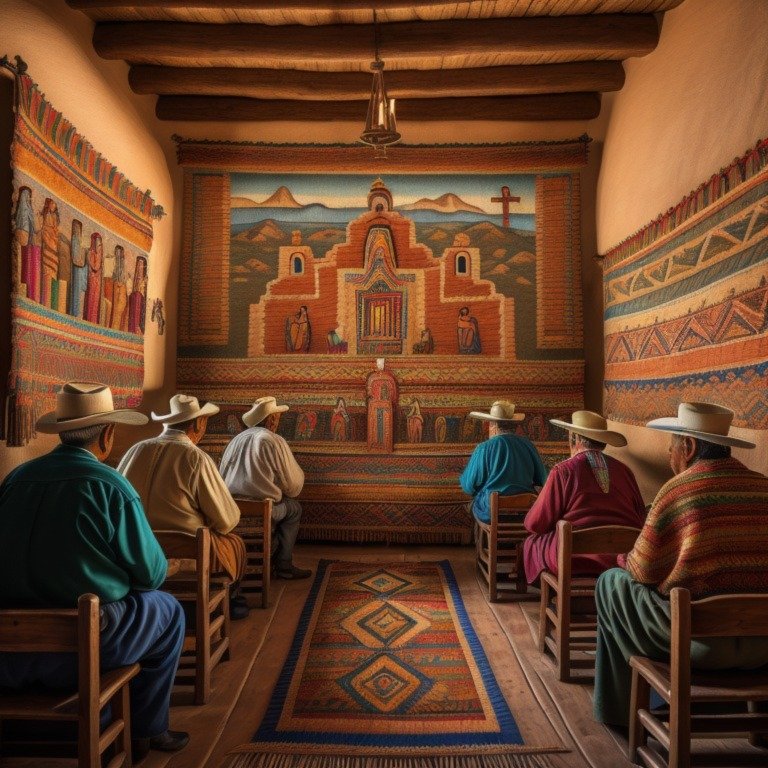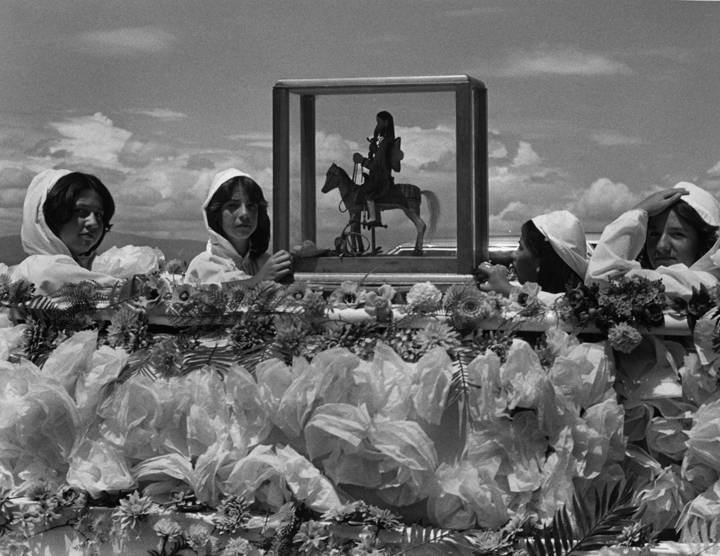Will New Mexico Sing Their Spanish in Heaven?
Christian Silva on embodiment, prayer, and Spanish-nuevomexicano
"Worshippers in Northern New Mexico," created with Imagine AI Art Generator. Image: Christian Silva
Though from Colorado, I grew up traveling to Alamogordo in southern New Mexico to visit family, especially to see our abuelos, where their sage-like status shaped us through storytelling and chisme. We also made efforts to make pilgrimages into northern New Mexico, to El Santuario de Chimayó, for healing. What I received was an identity marked by intergenerational culture and faith particular to the hybridity of nuevomexicana communities.
Amidst the many stories, there were also rumors of a strange Spanish spoken in the north — some of which our southern New Mexican vernacular shares. It was even said that their Spanish is like that of the original Spanish colonizers and that the northerners’ peculiar isolation preserved this dialect. The truth is not as romantic as one would think, however. The nuevomexicano dialect is dying with the elders to the north and, with them, the rumors.
¿Son hispan@s…y qué?
In the late sixteenth-century, Spanish colonizers established villages in the Sangre De Cristo Mountains, leading to the development of the New Mexican dialect spoken by the elders. Author and photographer Nancy Hunter Warren explores this cultural legacy in Villages of Hispanic New Mexico (School of American Research Press, 1987). Warren notes that these villages became isolated and impoverished during the eighteenth-century, resulting in “ [a] new and unique culture—a blend of Spanish, Mexican, and Pueblo Indian characteristics.” English influence arrived after the Anglo-American occupation, consequently shaping the dialect as it is today.
San Ildefonso woman at Christmas Day buffalo dance, San Ildefonso Pueblo, 1989. Photo: Nancy Hunter Warren. Publisher: Palace of the Governors Photo Archive, New Mexico History Museum, Santa Fe, NM [Negative Number: HP.2003.29.037].
Girls in procession honoring Señor Santiago, Chimayo, New Mexico, 1987. Photo: Nancy Hunter Warren. Publisher: Palace of the Governors Photo Archive, New Mexico History Museum, Santa Fe, NM [Negative Number: HP.2003.29.33].
Many villagers, says Warren, identify strongly as hispanos. In The Language of Blood: The Making of Spanish-American Identity in New Mexico, 1880s-1930s (University of New Mexico Press, 2008), nuevomexicano historian John M. Nieto Phillips argues that some have historically favored a Spanish-American identity, rather than a “brown” one, out of an anti-Mexican sentiment in order to survive in the United States, thus developing a complex and diverse perspective on Hispanic identity in New Mexico.
Defining “Hispanic,” however, depends on the subjectivity of the individual, explains New Mexico State University professor Larry Torres. He believes that the cultural and linguistic conversation in the northern region of New Mexico is intrinsically diverse and not solely rooted in a Spanish identity. Torres suggests further that a sense of “orphan-ness” in these communities contributed to the development of languages that are “neither-nor.”
While the United States Census Bureau determined that 50.2 percent of New Mexicans identified as Hispanic/Latino in 2022, Torres and Phillips have established, however, that the meaning of a Hispanic or hispano may carry different connotations for speakers of the dialect that I have come to call, Spanish-nuevomexicano.
Spanish-nuevomexicano speaker Adonio Pacheco, 84, from Chamisal, New Mexico. His ancestors are rooted in the Sangre de Cristo Mountains of Northern New Mexico. “Adonio Pacheco, New Mexico Spanish,” TimReevesVideo, YouTube, 2017.
Pray in Spanish…it’s stronger
The Spanish-nuevomexicano dialect may be survived by speakers like Adonio Pacheco from Chamisal New Mexico, but as the older generations pass on, so does their Spanish. The younger generations have become anglicized, thus leaving behind this heritage language. “Its best chance for survival is prayer,” according to Associated Press journalist and University of Minnesota professor Giovanna Dell'Orto.
But prayer alone may not be enough.
Dell'Orto explains that the prayers are preserved by the Catholic brotherhood of St. Isidore the Farmer, who recite from cuadernos (handbooks of prayer and hymns) for service and prayer. Dell'Orto quotes Gabriel Meléndez, who proclaims, “When prayers are said in Spanish, they’re stronger. They connect us directly to people who came before us.” Intergenerational faith and oral traditions are preserved in a Spanish spoken nowhere else beyond New Mexico–except, perhaps, en el cielo.
In an effort to preserve Spanish-nuevomexicano, professor, folklorist, and musician Rubén Cobos wrote A Dictionary of New Mexico & Southern Colorado Spanish (Museum of New Mexico Press, 1983). Inside, a linguistic treasure exists. With its unique conjugations and words comes an embodiment particular to its speakers: words like ajamachar, meaning “to haggle a price or the quality of a good,” and aguinaldo, a present or treat given to children on the Epiphany referenced in a folk prayer. Memories of ajamachando and going door-to-door in search of an aguinaldo are embodied experiences. Yet, if all that is left are words on a page, devoid of the bodies that spoke them, then what use are prayers if they are not enacted by humans?
We should not just attempt to preserve a language, but rather we must preserve the people behind what is spoken. If we do not have a preferential option for people, we reduce humans to their intellectual contributions and abilities.
Altar at the historic Roman Catholic church and shrine El Santuario de Chimayó, Chimayó, New Mexico, 2013. The National Historic Landmark is visited by nearly 300,000 visitors per year. Photo: speedygroundhog
That’s not how you use that word en español
I love to teach. I especially love teaching Spanish to my non-Spanish-speaking friends. Explaining a word like aitegüacho — New Mexican slang that means much more than “see you later” — is difficult. My friends were not there when my Abuelita said “aitegüacho” with a kiss on my cheek and handed me a bag of Hatch green chile burritos for the trip back home. Aitegüacho means much, much more to me than “see you later.”
In “Theologies That Resemble Our People” (HTI Open Plaza, 13 March 2023), doctoral student Emanuel Padilla writes that culture passes generationally through cultural memes not limited to a graphical GIF. He sturdily suggests that culture can be a dicho (proverb) and that “[a]ny imitation or replication of a cultural trait is a meme. Likes genes…memes are hereditary.” In New Mexico, memes look like devotional art pieces known as retablos, like family green-chile recipes, and like the heritage language passed from generation to generation. To some extent, Spanish-nuevomexicano has survived strictly through memes.
“Intergenerational faith and oral traditions are preserved in a Spanish spoken nowhere else—except, perhaps,
en el cielo.”
Left: Nuestra Señora de los Dolores by Pedro Antonio Fresquís (1741-1831), a 12 x 6 inch retablo from the New Mexico History Museum exhibition “Treasures of Devotion/Tesoros de Devoción” (July 20, 2008-August 1, 2018). Source: New Mexico Department of Cultural Affairs
Still, the threat of Spanish-nuevomexicano’s extirpation as a spoken dialect is very real. Doing theology “from our people” will have to exist through memories and written prayers in a dialect that may no longer be understood fully, except in the distant memories of our grandparents’ words and phrases said in passing.
I argue here that, as New Mexicans (despite our geographical differences), we ought to seek embodiment in the dialect of our people. More so, we ought to embody our prayers by bridging historical and contemporary experiences. The memes of our peoples can only live through us and through our unique vernacular. Without our people, the written prayers and recorded videos will just be cacaraqueo (cackling or chatter). But what is true, and will remain so, is that the prayers of nuevomexican@s e hispan@s are innately human and divine.
As conservation efforts hopefully advance, we would be good to remember that the prayers that survive the dialect were — no, are — embodied. It was human beings who spoke divine vibrations into the static, spiritless air of chapels, and those fellow human beings who listened were moved to write down the words. It was human bodies that wrote, and human bodies that preserved these alabanzas.
In Cobos’ Dictionary of New Mexico and Southern Colorado Spanish, the definition for “alabanza” includes an “ode offering homage” to the dawn:
Cantemos l’alba
ya viene el día;
daremos gracias
¡Ave María!
[Let’s praise the dawn
The day is breaking;
Let’s all give thanks
Hail Mary!]
As this heritage language faces extinction, let us ajamachar with God that the sun will rise again for the hispan@s of New Mexico to say yet another prayer in Spanish-nuevomexicano.






